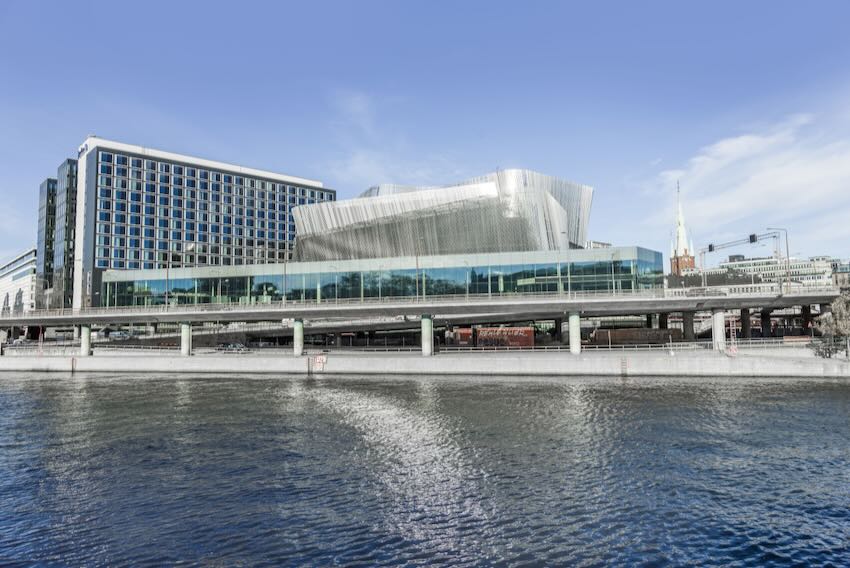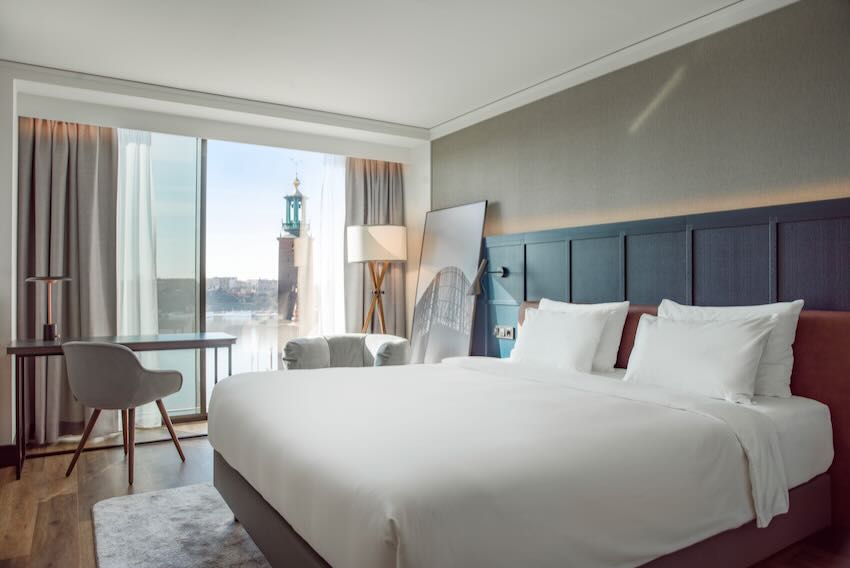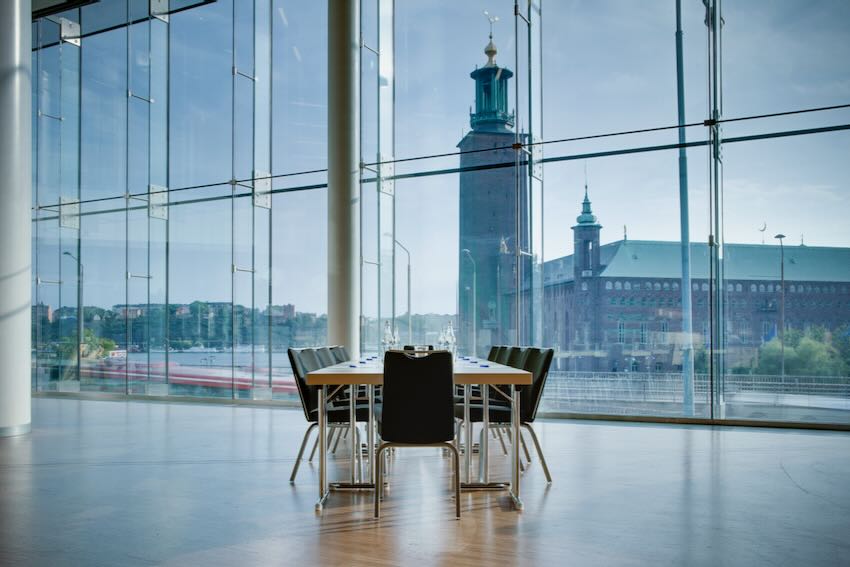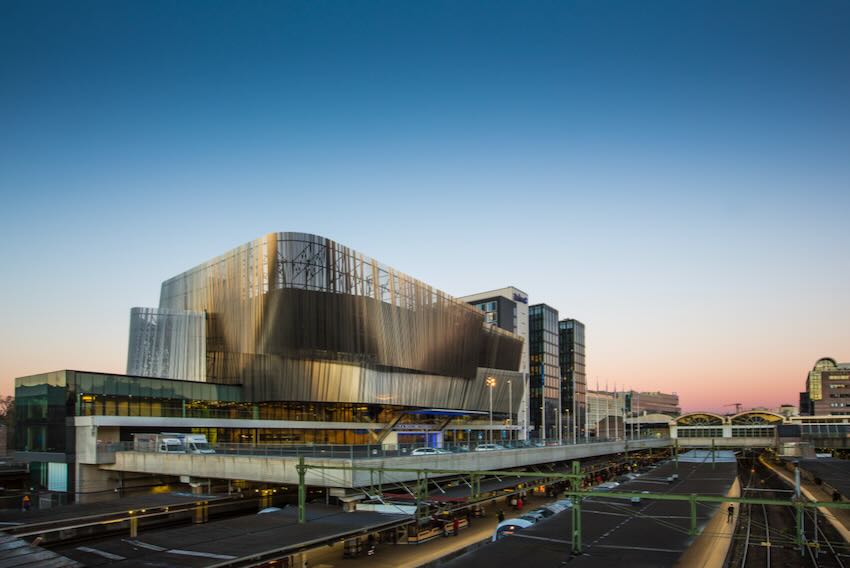
About: In 1989 Radisson Hotel Group was the first hotel group in the world to adopt an environmental policy with its Think Planet targets to reduce its environmental footprint and begin to measure progress. The Science Based Target Initiative (SBTi) has verified and approved Radisson Hotel Group’s near-term and net zero science-based emissions reduction targets and the Group is committed to reducing greenhouse gas emissions by 46 per cent by 2030, reaching science-based net zero by 2050. The Group has already reduced its carbon footprint per square meter by 35 per cent since 2019. The worldwide hotel group is also part of the Global Reporting Initiative and it has signed the UN Global Compact Compliance and the UN CEO Water Mandate.
Radisson Blu Waterfront Hotel, Stockholm was built in 2011 and a large part of the material from the building that previously stood on the site was reused. This was the beginning of creating a sustainable facility with intelligent energy solutions, focused on reducing CO2 emissions and minimising environmental impact. The hotel is connected to the Stockholm Waterfront Congress Centre, which hosts regular events for up to 3,000 people. It’s a modern light filled space overlooking the waterfront with views to Stockholm City Hall and beyond.
Arrival: The hotel entrance is a step away from a connecting walkway to Stockholm’s Central station, so if you are flying or taking the train it’s easy and convenient to get to the hotel. The Arlanda Express takes 18 minutes from the airport to the centre of the city and the hotel is also a short walk to one of Stockholm’s main streets, where I took the tram to get around to different islands across the city. It’s easy to jump on buses and trams and overland trains using the SL app to book tickets. There are various options but with a single ticket you can jump on and off as many different modes of transport as you like within 75 minutes. One day I realised I was standing next to Greta Thunberg on the tram.
This is a large contemporary hotel and as you enter the lobby, which has recently been refurbished, there are self-service check-in and check-out kiosks and a cosy Lobby Bar on the right, which was lively during the day and night with people chatting with colleagues or catching up on work. It is open until midnight all week and 1am on a Saturday.
Straight ahead are the reception desks. It was busy when I arrived at around 2pm but I didn’t have to wait long to be checked in, and I headed to the lifts (you have to use your keycard to access the guest room floors).
How many rooms? 414 rooms and suites. All rooms and public areas have been refurbished in 2023 and everything feels modern, airy and clean. A lot of the rooms overlook the bay and waterfront. There are nine accessible rooms all located on the 5th floor, which is the lowest floor with hotel rooms. Those that are accessible for wheelchairs have wider and automatic doors, bathrooms designed for wheelchairs, as well as more space around the bed. All accessible rooms can also be connected to a standard room.
The room: My room was on the 16th floor with views over the bay and Stockholm City Hall, where the Nobel Peace Prize dinner is held. The decor was earthy browns and breezy whites and large black and white photos of old Stockholm leaning against the walls. The room had an ‘open’ wardrobe rail to hang clothes, a safe and tea and coffee making facilities. The smart TV was on the wall opposite the bed. The bathroom had a rain shower with refillable body wash. Towels are only replaced if you leave them off the rails. I could hang a “do not clean my room” sign on my door to save on energy. Guests who opt for green housekeeping are given drinks tokens to be used at that hotel during their stay.

Breakfast: The RBG Bar and Grill restaurant seats 170 people and was busy at peak times for breakfast. During the week breakfast is open 6.30am-10am and at weekends from 7am-12pm. There is a large area with smaller ‘inlets’ off the main room, which were a little quieter. The buffet options are extensive with everything from fully cooked breakfast, eggs cooked different ways, local herring with dill sauce, smoked salmon, pastries, yoghurts and fruits, cereals, cold meats and cheese. There was a self service tea and coffee machine with sweet treats like brownies and biscuits.
Working: I found it peaceful and easy to work at my desk in my room for a few hours with the coffee machine on hand, and the small desk overlooking the water and islands beyond. There is also a business centre in the hotel.
Events: The Stockholm Waterfront Congress Centre is attached to the hotel and can host 3,000 people across 14,000 square meters and 24 meeting rooms of varying sizes. The floor plans and photos for the different spaces can be found here. This impressive building is one of the most sustainable events centres in the world and all events which take place here are 100 per cent carbon neutral. (See our section on sustainable practices below for how a building of this size achieves that). The space can be shifted and moved, divided up and adjusted with siding walls, adapting to the event structure.

Sustainable practices: I sat down with Sam Holmberg, general manager of the Radisson Blu Waterfront Hotel, Stockholm, after he had shown me the Stockholm Waterfront Congress Centre and the sustainable heating systems. We chatted about the industry and sustainability for a while. Holmberg went to hotel school in the 1990s and, a passionate environmentalist himself, wanted to write about heating and cooling energy use in hotels for his specialism. Frustratingly, at the time no one had any interest in the environment. “For me it’s always been there – we can do it all but in all areas we need steps to make it better,” he said.
The hotel is on the same energy and heating system as the The Stockholm Waterfront Congress Centre and the large glass facades, around five football fields in length, (see the image which shows part of the glass facade) in the congress centre contains 1,040 sqm of solar panels that convert solar energy into electricity and heat. The panels collect 1 MW of thermal power per day (equivalent to 90,000 household compact fluorescent lamps). All lights in the hotel have been changed to LED and Holmberg says they are working on the Congress Centre to hopefully have LEDs by the end of the year.
Making use of the waterfront location, the hotel and congress centre are cooled by water pumped up from Lake Klara. Down in the basement are 250-tonne ice tanks where the water is stored. This technique is then used to control and regulate the temperatures across the two buildings. The technology has been well tested and the building has been using it for years so the hotel is able to transfer the energy between the people who need it.
Radisson Blu Waterfront Hotel, Stockholm is Green Key certified. The carpark has five EV charging stations, which are free to use for guests driving EV cars.

Gym? There’s a fitness centre open 24/7, which has natural daylight, or if you want to explore the city there are several jogging routes straight from the hotel. Stockholm is easy to navigate by foot.
Catching the Zzzs? When we review hotels for their sustainability initiatives we still need to get some sleep. This is the reason we stay in hotels after all. Yes I did sleep well here, the room was quiet, the thick curtains kept out the morning light and the room was a comfortable temperature.
Future: Radisson Hotel Group supports the World Sustainable Hospitality Alliance’s Pathway to Net Positive Hospitality, and the WTTC’s Hotel Sustainability Basics. Currently 50 per cent of the Group’s hotels are in the process of verification and 179 hotels are fully Hotel Sustainability Basics verified. Another 165 hotels are certified with an eco-label.
Federico González, executive vice chairman, Radisson Hotel Group says: “Sustainability is a core part of our Strategic 5-year Plan and is closely connected to other key initiatives, driving our vision as a meaningful brand for guests, owners, and talent. We continue to invest in ESG and focus on cost efficiencies, as well as the revenue opportunities of being a responsible business. Together with key stakeholders and associations, we believe in driving and growing sustainable travel and making sustainability an intrinsic part of our 10 leading brands.”
Felicity Cousins stayed at the Radisson Blu Waterfront Hotel, Stockholm in mid April 2024. Images supplied by Radisson Hotel Group.
For our recent Q&A with Sven Wiltink global senior director of Responsible Business Radisson Hotel Group see below.
Q&A: Sven Wiltink global senior director of Responsible Business Radisson Hotel Group

